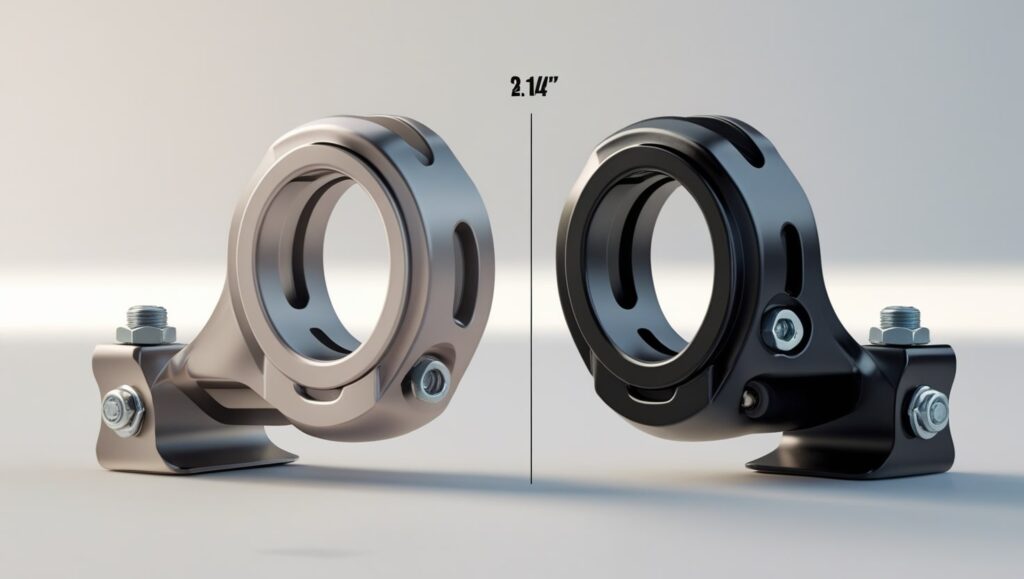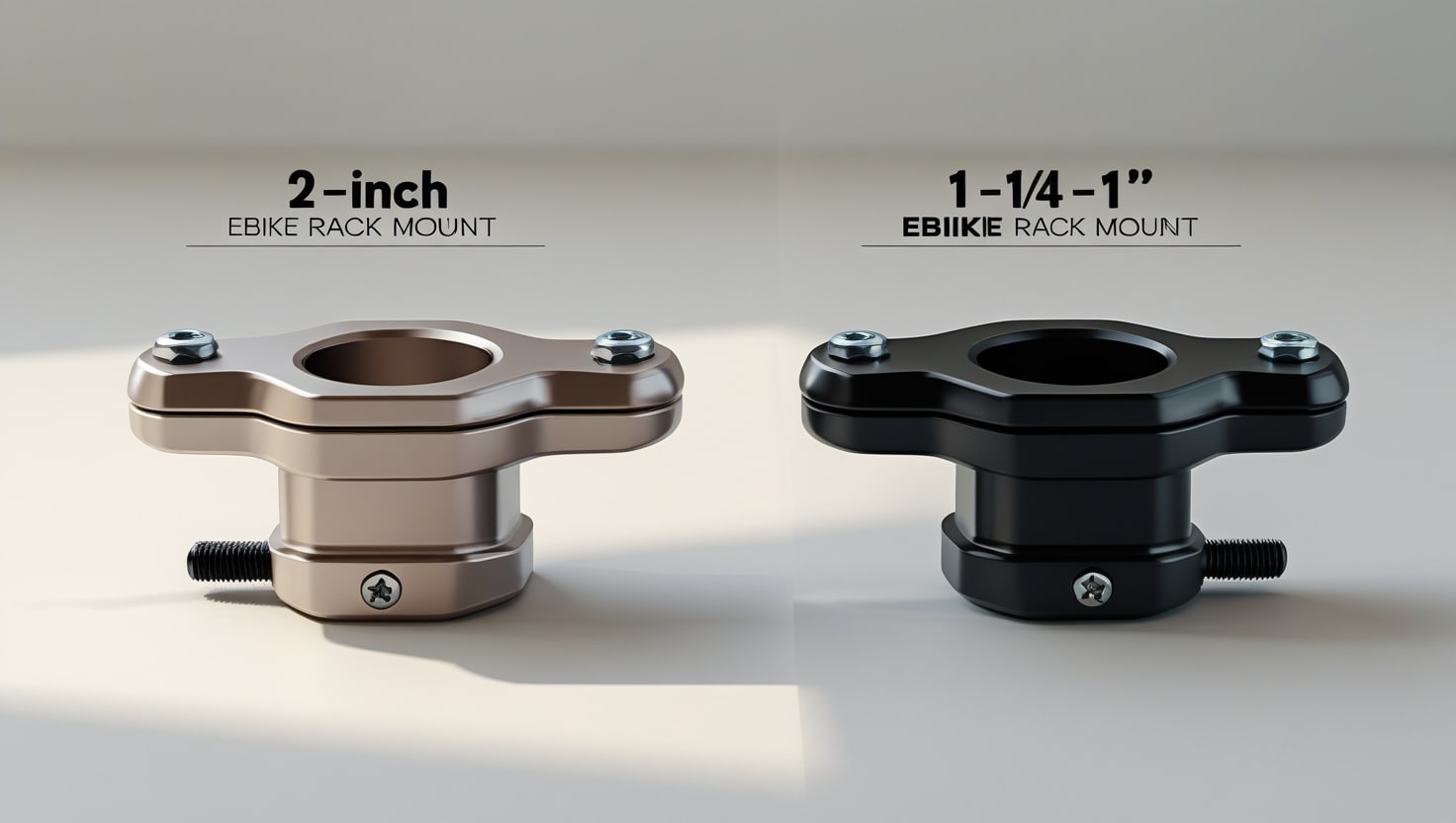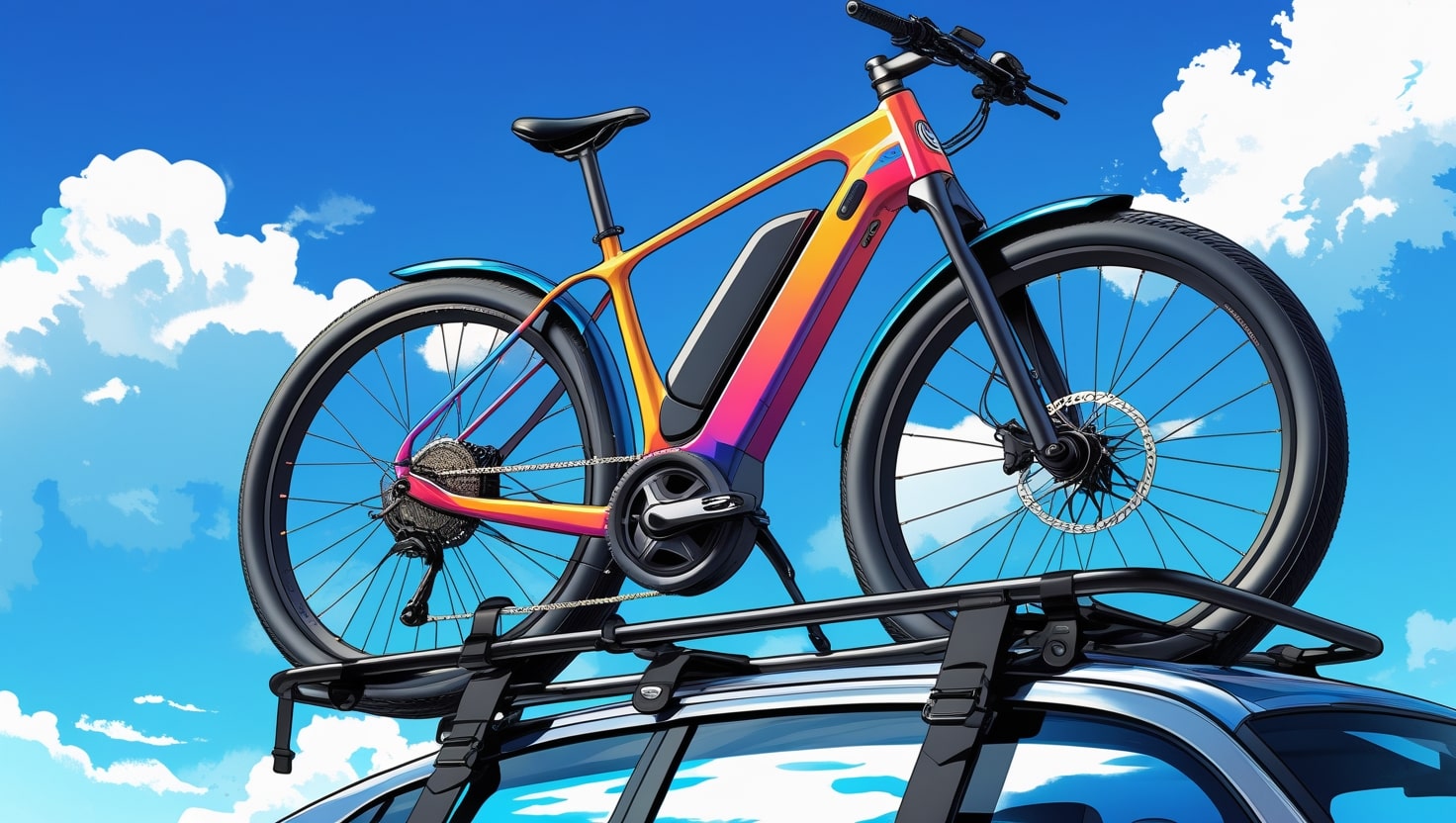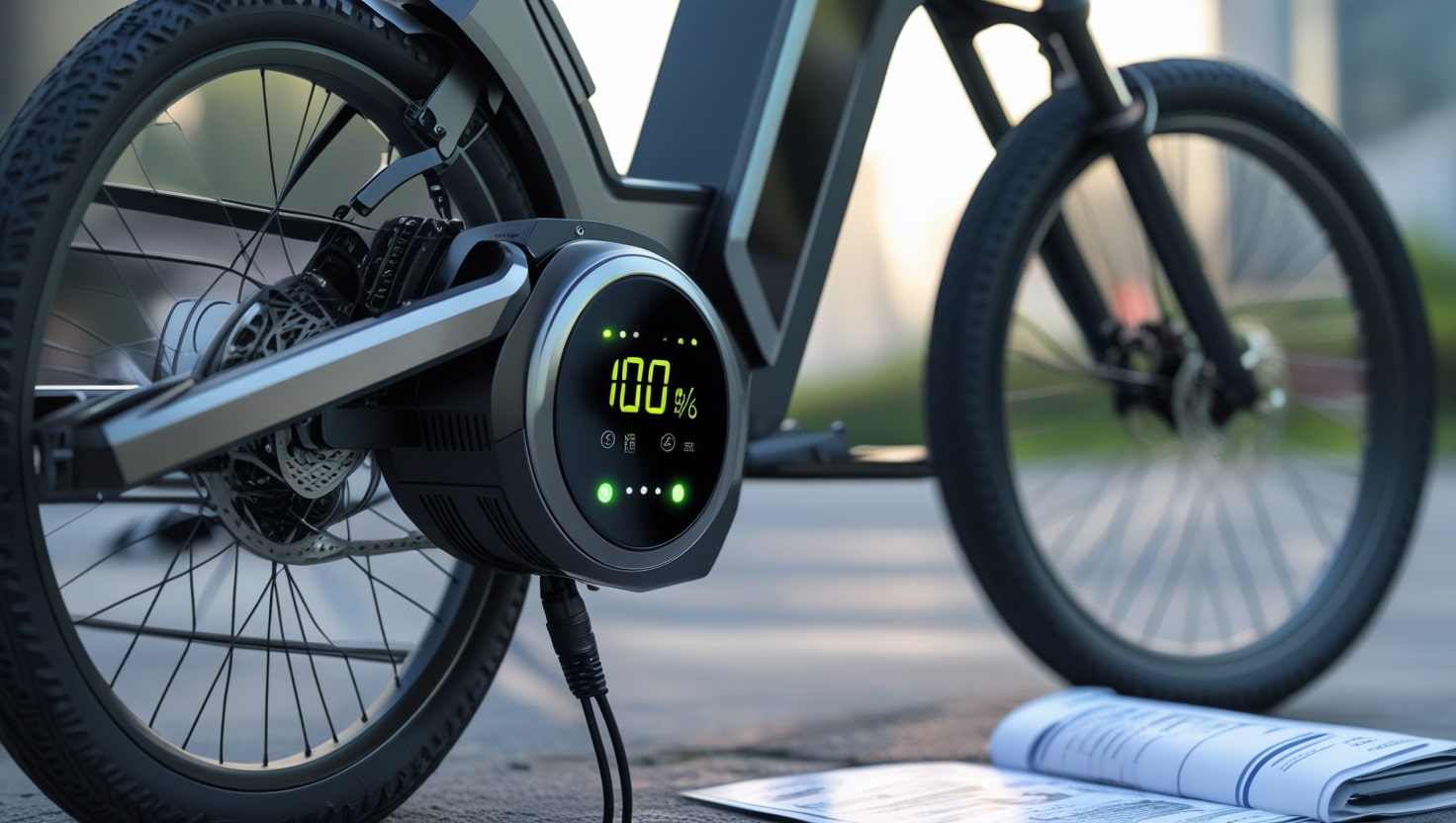When I first got my ebike, figuring out how to securely carry it on my vehicle was a puzzle. I learned quickly that the difference between 2in and 1 1/4 in ebike rack mount options goes far beyond just size. These mounts are more than just accessories; they’re essential for safe transportation. A 2-inch hitch is typically found on larger SUVs or trucks and offers a more stable, reliable platform—ideal if you’re hauling a heavier electric bicycle or multiple bikes.
On the other hand, the 1-1/4-inch mount might fit better on smaller cars, but it’s important to weigh in the weight of your bike and your specific needs. The rack you choose must match the receiver on your hitch, and that choice really hinges on several factors—from transporting habits to what your car can handle.
Hitch Receiver Sizes
2-Inch Hitch Receivers
When I upgraded to a heavier ebike, I quickly realized my compact car’s hitch wasn’t going to cut it. Switching to a 2-inch hitch on my SUV was a game-changer. This standard size, found on many trucks and SUVs, is designed to handle heavier bikes with ease. What stood out most was the stability—no more sway on the highway. These receivers can support up to 500 lbs, making them ideal for multiple e-bikes or a bike plus extra cargo.
Beyond just strength, the 2-inch hitch opens up a wider range of features and attachments. It’s compatible with bulkier racks, carriers, and other accessories that simply wouldn’t fit a smaller mount. Whether it’s transportation of extra gear or just wanting something more suitable for your setup, this larger receiver is hard to beat. In my case, the ability to mount larger racks and carry multiple bikes safely was worth every penny. The design even helps reduce movement and keeps everything secure.
1-1/4-Inch Hitch Receivers
When I explored the 1-1/4-inch option. It’s suitable for smaller vehicles like sedans, compact SUVs, and mid-size cars, all of which usually have limited ground clearance and less space. The receiver in this category is more practical for setups where a heavier rack isn’t needed. Though it has a lower weight capacity, it’s still sufficient for most standard ebikes, and it usually supports up to 200 lbs—enough for one or two bikes.
One of the best features of the 1-1/4-inch design is how much easier it is to install and handle, especially if you’re working with a tight garage or narrow driveway. It’s also typically more budget-friendly and doesn’t require heavy-duty parts. As long as you’re mindful of capacity and the number of ebikes, it’s a reliable pick for everyday vehicles with lighter hauling needs.

Key Difference Between 2in and 1 1/4 in Ebike Rack Mount
Weight Capacity:
One of the biggest things I noticed when switching between mounts was the weight difference they could handle. A 2-inch mount is designed to carry more—it easily supports multiple ebikes or bikes, even when loaded to maximum capacity. This makes it perfect for heavy-duty use or long-distance trips. On the other hand, a 1-1/4-inch option is suitable for lighter loads and fewer bikes. If you’re just transporting one bike, and it’s not an especially heavy model, this smaller mount can work fine without compromise.
Stability and Durability:
In my experience, the stability and sturdiness of the 2-inch rack are hard to beat. It offers greater resistance to wobbling, swaying, and bounce during transit, especially on rough roads or during long trips. That added strength is important when your gear is expensive or bulky. A 1-1/4-inch rack is still stable, but it doesn’t offer the same level of support when fully loaded. If you’re traveling far or over uneven terrain, the stronger rack just feels safer.
Vehicle Compatibility:
Your car has a big influence on which of these two sizes you choose. Most larger vehicles—like full-size SUVs and trucks—are equipped with a 2-inch hitch receiver, while smaller cars are often fitted with a 1-1/4-inch receiver. Checking your hitch compatibility is key to ensuring a secure and safe fit. I always recommend knowing your vehicle’s limitations before you buy. Good transportation starts with the right match between rack and car.
Ease of Installation:
From a practical angle, installing a 2-inch rack can be more challenging. It usually requires extra tools, assistance, and patience due to its size and weight. I’ve had to ask a friend to help me attach and detach it more than once. In contrast, the 1-1/4-inch version is noticeably easier to handle. It’s a convenient option for solo riders or those who frequently remove their racks.
Comparative Analysis of Pros and Cons
2-Inch Ebike Rack Mounts
Pros:
Supports a higher weight limit—up to 500 lbs—making it ideal for multiple ebikes or heavy-duty use.
Offers greater stability with reduced sway during transport, especially over rough terrains, which improves safety on the road.
Built for durable, heavy-duty setups and more demanding riding situations.
Provides better versatility as it is compatible with a wider range of accessories and can fit larger vehicles with ease.
Cons:
Often bulkier and more challenging to install, sometimes requiring extra tools and help to handle.
Generally more expensive than a 1-1/4-inch option in terms of both purchase cost and setup.
Not suitable for smaller cars due to lower ground clearance—may not fit or can cause interference with the vehicle body.
1-1/4-Inch Ebike Rack Mounts
Pros:
Best suitable for smaller vehicles, cars, and urban environments where space is tight and clearance is low.
Lightweight and compact, making it much easier to install and manage without help.
Cost-effective option, as it’s typically less expensive than a 2-inch setup.
Adequate support for standard ebikes or bikes, especially when carrying just one or two units.
Can handle up to 200 lbs, which is plenty for many loads.
Cons:
Lower capacity means it may not support heavier or multiple ebikes and gear.
Less stability during transport, with more sway on rough roads or at higher speeds.
Limited compatibility with certain types of accessories, especially compared to the wider options available for 2-inch mounts.

How to Choose an Ebike Rack Mount
Weight of Your Ebike:
The weight of your ebike plays a big role in determining the right rack mount. A 2-inch mount has a higher capacity, making it ideal for heavy-duty ebikes or if you’re transporting multiple bikes. If you’re riding a standard bike and rarely carry more than one, a 1-1/4-inch option is more than appropriate.
Frequency of Use:
If you’re a frequent rider who relies on your rack regularly, you’ll appreciate the durability, stability, and strength that come with a 2-inch rack. Frequent users often find these features more beneficial in the long run. However, if your riding schedule is occasional, the convenience and ease of a 1-1/4-inch mount may better suit your needs.
Type of Vehicle:
Before you settle on a mount, check your vehicle and hitch receiver. Many small cars don’t come compatible with a 2-inch hitch out of the box. While adapters are available, sticking with the correct size is usually more secure and straightforward. From my experience, the right choice depends on what fits your vehicle best—not just what seems strongest or more expensive.
Budget:
Your budget is another important factor. 2-inch mounts are typically more expensive due to their enhanced features and higher load capacity. If cost is a major concern and you’re not planning on heavy hauling, a 1-1/4-inch rack can save money without sacrificing safety.
Installation Considerations:
Ease of Installation: Go for a mount that is simple to install and remove, especially if you plan to take it on and off frequently.
Security: Make sure the mount has a secure fit to help prevent theft or unexpected accidents while driving. A loose rack can cause serious problems, so investing in security from the start pays off.
Accessories Compatibility: If you plan to expand your setup, check for compatibility with accessories. A good rack should accommodate additional gear you may need, whether that’s a light bar, cargo tray, or extra locking mechanisms.
Why Rack Mount Size Matters
Impact on Safety:
The impact of choosing the correct rack mount goes beyond just whether your bike fits. A secure connection between the rack and your vehicle is essential for preventing damage, wobble, or worse—accidents on the road. If a rack isn’t properly attached, it becomes unsafe and can cause serious concerns, especially on long trips. From personal experience, using the wrong size has led to noticeable movement that made me nervous on the highway. The right size helps keep things secure, especially when driving over uneven terrain.
Performance and Handling:
Rack performance plays a big role in how your vehicle handles. A 2-inch mount helps distribute the weight of heavier ebikes more evenly, which improves balance and reduces strain on the hitch receiver. In contrast, a 1 1/4-inch mount might be suitable for lighter setups or smaller cars, but it may affect handling when carrying more than one bike.
Load Capacity:
The load capacity of your rack should always match your hauling needs. A 2-inch rack can typically handle more weight, making it ideal for multiple ebikes, heavy gear, and bigger setups. On the other hand, a 1 1/4-inch rack is better for single bike transport or when your gear is lighter. Overlooking this factor can lead to overloading, which may damage your rack or even your vehicle.
Stability During Transport:
During long trips or bumpy roads, stability is critical. A 2-inch mount has a larger contact area, which helps reduce wobble and keeps your bikes stable. The movement from a smaller mount, especially if used beyond its intended capacity, can be a big concern.
Compatibility with Different Vehicles:
Last but not least, compatibility with the receiver in your car is crucial. Not all vehicles are designed to work with a 2-inch mount. Many smaller cars come equipped with a 1 1/4-inch hitch, and using the wrong size may be problematic. Always check what your car supports before installing. Forcing a mount that doesn’t match can cause installation issues or worse—an insecure fit that puts your entire setup at risk.
Specialized Considerations
Heavy-Duty Usage:
A 2-inch mount is essential if you intend to travel frequently or for extended periods of time, particularly if you are transporting several bulky e-bikes. Its robust construction and durable design provide the stability and strength needed for demanding conditions. From my own experience hauling two large eBikes across state lines, the heavy-duty setup proved far more reliable than anything lighter. Over time, the long-lasting materials and higher capacity mean fewer problems and more peace of mind, even when fully loaded.
Urban vs. Off-Road Use:
When it comes to daily urban rides and squeezing into tight parking spaces, a 1 1/4-inch mount is often more than sufficient. It’s easier to maneuver, store, and perfect for lighter loads or a single bike. However, if you’re heading out for off-road adventures across rough terrains, the 2-inch model offers higher stability and ensures your setup stays secure on bumpy roads.
Maintenance and Care
| Task | 2-inch eBike Rack Mounts | 1 1/4-inch eBike Rack Mounts |
|---|---|---|
| Inspection | Before each journey, look for wear, cracks, and corrosion. Tighten all bolts and connections. | Inspect regularly for damage, rust, and wear. Tighten bolts and connection points as needed. |
| Cleaning | To get rid of filth and grime, wash with water and mild soap. Dry thoroughly to prevent rusting. | Use mild soap, clean off grime and dirt, and keep it dry to avoid rust or moist buildup. |
| Lubrication | Lubricate hinges and moving parts with bike-specific lubricant to ensure smooth operation. | Apply lubrication to parts and hinges to maintain ease of use. |
| Bolt Tightening | Check and tighten all bolts and connections monthly or before long trips. | Tighten all bolts before each trip, especially on longer journeys. |
| Rust Prevention | Apply a spray or coating to prevent rust, especially in moist or humid areas. | To shield the mount from weather exposure, use rust-prevention techniques. |
| Damage Inspection | Inspect for structural issues like cracks, and replace worn parts if necessary. | Check for wear, cracks, and replace any part that shows damage. |
| Storage | Store in a dry, sheltered place to avoid weather-related issues. | Keep it covered in a dry area when not in use to protect from weather and elements. |
| Wobble Prevention | If wobbling occurs, use anti-wobble devices or features to adjust and keep it secure. | Watch for any wobble, and use adjustable anti-wobble tools to keep the rack steady. |
| Manufacturer’s Guide | Always refer to the manufacturer’s guide for detailed maintenance tips and instructions. | Follow the manufacturer’s guide for specific recommendations and care instructions. |
Conclusion
After using both 2-inch and 1-1/4-inch mounts over the years, I’ve learned that choosing the right option comes down to understanding the differences and matching them with your specific requirements. You need to consider the weight of your ebike, your vehicle type, and how often you’ll be using it for transportation.
While each mount has its own advantages, one may be better suited than the other depending on your setup. A 2-inch mount, for example, is often more secure and convenient for heavier loads, while a 1-1/4-inch can be perfect for lighter bikes and smaller vehicles. Whatever you select, ensuring a safe and stable rack fit is key to enjoying your ride with peace of mind.
FAQs
Can a 1-1/4-inch rack mount handle two ebikes?
Yes, a 1-1/4-inch rack mount can handle two standard ebikes as long as their combined weight does not exceed the mount’s capacity, which is typically rated around 200 lbs.
Is there a significant difference in stability between 2-inch and 1-1/4-inch mounts?
Yes, there is definitely a noticeable difference in stability when comparing 2-inch mounts to smaller ones, especially if you’re carrying heavier loads over rough terrains. The 2-inch option provides greater support and significantly reduced sway during transport, which is important for keeping your bikes steady and safe.
Are there any accessories that only fit 2-inch rack mounts?
Yes, some accessories—especially larger cargo carriers and heavy-duty bike racks—are specifically designed to fit 2-inch rack mounts due to their higher weight capacity.
What size hitch should I get for a bike rack?
To pick the right hitch size, you need to match it with your vehicle, receiver, and the weight of your bike or ebikes. A 2-inch hitch is recommended if you’re carrying heavier bikes, multiple ebikes, or using larger rack setups. On the other hand, for lighter, single-bike transportation, a 1 1/4-inch hitch is typically adequate. From my own experience, checking compatibility is key—some cars may not support larger receivers, so always confirm your requirements before choosing.








